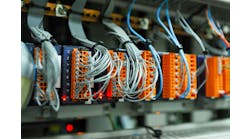Here is the Fourth part of a point blank decisive comprehensive list of what we really need to know in a detailed attempt to reduce the disparity between theory and practice. Please read, think and take to heart the opportunities to increase the performance and recognized value of our profession. The list is necessarily concise in detail. If you want more information on these opportunities, please join the ISA Mentor Program and ask the questions whose answers can be shared via Mentor Q&A Posts.
You can also get a comprehensive resource focused on what you really need to know for a successful automaton project including nearly a thousand best practices in the 98% new 2019 Process/Industrial Instruments and Controls Handbook Sixth Edition capturing the expertise of 50 leaders in industry.
-
Eliminate air gap in thermowells to make a temperature response much faster. Contrary to popular opinion, the type of sensor is not a significant factor in the speed of the temperature response in the process industry. While an RTD may be a few seconds slower than a TC, the annular clearance around the sheath can cause an order of magnitude larger measurement time lag. Additionally, a tip not touching the bottom of the thermowell can be even worse. Air is a great insulator as seen in the design of more energy efficient windows. Spring loaded tight fitting sheathed sensors in stepped metal thermowells of the proper insertion length are best. Ceramic protection tubes cause a large measurement lag due to poor thermal conductivity. Low fluid velocities can cause an increase in the lag as well. See the Control Talk column “A meeting of minds” on how to get the most precise and responsive temperature measurement.
-
Use the best glass and sufficient velocity to keep pH measurement fast by reducing aging and coatings. A aged glass electrode due to even moderately high temperature (e.g., > 30 oC), chemical attack from strong acids or strong bases (e.g., caustic) or dehydration from not being wetted or exposed to non-aqueous solvents can increase the sensor lag time by orders of magnitude. High temperature glass and specific ion resistant glasses are incredibly beneficial to sustain accuracy and a clean healthy electrode sensor lag of just a few seconds. Velocities must be greater than 1 fps for fast response and greater than 5 fps to prevent fouling that can also increase sensor lag by orders of magnitude by almost imperceptible coatings. This is helpful for thermowells as well but the adverse effects in terms of slower response time are not as dramatic as seen for pH. Electrodes must be kept wetted and exposure to non-aqueous solvents and harsh process conditions reduced by automatically retractable assemblies with ability to soak in buffer solutions. See the Control Talk column “Meeting of minds encore” on how to get the most precise and responsive pH measurement.
-
Avoid the measurement lag becoming the primary lag. If the measurement lag becomes larger than the largest process time constant, the trend charts may look better due to attenuation of oscillation amplitude by the filtering effect. The PID gain may even be able to be increased because the PID does not know where the primary lag came from. The key is that the actual amplitude of the process oscillation and the peak error is larger (often unknown unless a special separate fast measurement is installed). Seen on the trend charts is the fact the period of oscillation is larger possibly to the point of creating a sustained oscillation. Besides slow electrodes and thermowells, this situation can occur simply due to transmitter damping or signal filter time settings. For compressor surge and many gas pressure control systems, the filter time and transmitter damping settings must not exceed 0.2 sec. For a much greater understanding, see the Control Talk Blog “Measurement Attenuation and Deception Tips”.
-
Real rangeability of a control valve depends upon ratio of valve drop to system pressure drop, actuator and positioner sensitivity, backlash, and stiction. Often rangeability is based on the deviation from an inherent flow characteristic leading to statements that a rotary valve often designed for on-off control as having the greatest rangeability. The real definition should depend upon minimum controllable flow that is a function of the installed flow characteristic, sensitivity, backlash and stiction near the closed position, all of which are generally worse for these on-off valves that supposedly have the best rangeability. The best valve rangeability is achieved with a valve drop to system pressure drop ratio greater than 0.25, generously sized diaphragm actuators, digital positioner tuned with high gain and no integral action, low friction packing (e.g., Enviro-Seal), and a sliding stem valve. If a rotary valve must be used, there should be a splined shaft to stem connection and stem integrally cast with ball or disk to minimize backlash and a low friction seal or ideally no seal to minimize stiction. A graduated v-notch ball or contoured butterfly should be used to improve flow characteristic. Equations to compute the actual valve rangeability based on pressure drop ratio and resolution are given in Tuning and Control Loop Performance Fourth Edition.
-
Real rangeability of a variable frequency drive (VFD) depends upon ratio of static pressure to system pressure drop, motor design, inverter type, input card resolution and dead band setting. The best VFD rangeability and response is achieved by a static pressure to system pressure drop ratio less than 0.25, a generously sized TEFC motor with 1.15 service factor and Class F insulation, pulse width modulated inverter, speed to torque cascade control in inverter, and no dead band or rate limiting in the inverter setup.
-
Identify and minimize transportation delays. The delay for a temperature or composition change to propagate from the point of manipulated change to the process or sensor is simply the process volume divided by the process flow rate. Normal process design procedures do not recognize the detrimental effect of dead time. The biggest example is equipment design guidelines that have a dip tube designed to be large in diameter extending down toward the impeller. Missing is the understanding the incredibly large dead time for pH control where the reagent flow is a gph or less and the dip tube volume is a gallon or more. When the reagent valve is closed, the dip tube is back filled with process fluid from migration of high to low concentrations. To get the reagent to displace the process fluid takes more than an hour. When the reagent valve shuts off, it may take hours before reagent stops dripping and migrating into the process. To go from acid to base in split range control may take hours to displace the acid in the dip tube. The same thing happens to go from base to acid. The stiction is also highest at the closure position. When you consider pH is so sensitive, it is no wonder that pH systems oscillate across the split range point.
-
The real rangeability of flow meters depends upon the signal to noise ratio at low flows, minimum velocity, and whether accuracy is a percent of scale or reading. The best flow rangeability is achieved by meters with accuracy in percent of reading, minimal noise at low flows and least effect of low velocities including the possible transition to laminar flow. Consequently Coriolis flow meters have the best rangeability (e.g., 200:1) and magmeters have the next best rangeability (e.g., 50:1). Most rangeability statements for other meters is based on a ratio of maximum to minimum meter velocity and turbulent flow and do not take into account the actual maximum flow experienced is much less than meter capacity.
-
Use Coriolis flow meters for stoichiometric control and heating value control. The Coriolis flowmeter has the greatest accuracy with a mass flow measurement independent of composition. This capability is key to keeping flows in the right ratio particularly for reactants per the factors in the stoichiometric equation for the reaction (mole flow rate is simply mass flow rate divided by molecular weight of reactant). For waste fuels, the heat release rate upon combustion is a strong function of the mass flow greatly facilitating optimization of supplemental fuel use. Nearly all ratio control systems could benefit from true mass flow measurements with great accuracy and rangeability. For more on what you need to know to achieving what the Coriolis meter is capable of, see the Control Talk Column “Knowing the best is the best”.
-
Identify and minimize the total dead time. Dead time is easily identified on a properly scaled trend chart as simply the time delay between a manual output change or setpoint change and the start of the change in the process variable being controlled. The least disruption is usually by simply putting PID momentarily in manual and making a small output change simulating a load disturbance. The test should be done at different production rates and run times. The dead time tends to be largest at low production rates due to larger transportation delays and slower heat transfer rates and sensor response. Dead time also tends to increase with production run time due to fouling or frosting of heat transfer surfaces. See the Control Talk Blog “Deadtime, the Simple Easy Key to Better Control” for a more extensive explanation of why I would be out of a job if the dead time was zero.
-
Identify and minimize the ultimate period. This goes hand in hand with knowing and reducing the total loop dead time. The ultimate period in most loops is simply 4 times the dead time in a first order approximation where a secondary time constant is taken as creating additional dead time. Dead time dominant loops have a smaller ultimate period that approaches 2 times the dead time for a pure dead time loop (extremely rare). Input oscillations with a period between ½ and twice the ultimate period result in resonance requiring less aggressive tuning. Input oscillations less than ½ the ultimate period can be considered to be noise requiring filtering and less aggressive tuning. Oscillations periods greater than twice the ultimate period, are attenuated by more aggressive tuning. Note that input oscillations persist when the PID is in manual. For damped oscillations that only appear when the PID is in auto, an oscillation period close to ultimate period indicates too high a PID gain and more than twice the ultimate period indicates too low a PID reset time. A damped oscillation period approaching or exceeding 10 times the ultimate period indicates a violation of the gain window for near-integrating, true integrating or runaway processes. Oscillations greater than four times the ultimate period with constant amplitude are limit cycles due to backlash (dead band) or stiction (resolution limit). See the Control Talk Blogs “Controller Attenuation and Resonance Tips” and “Processes with no Steady State in PID Time Frame Tips” for more guidance.




